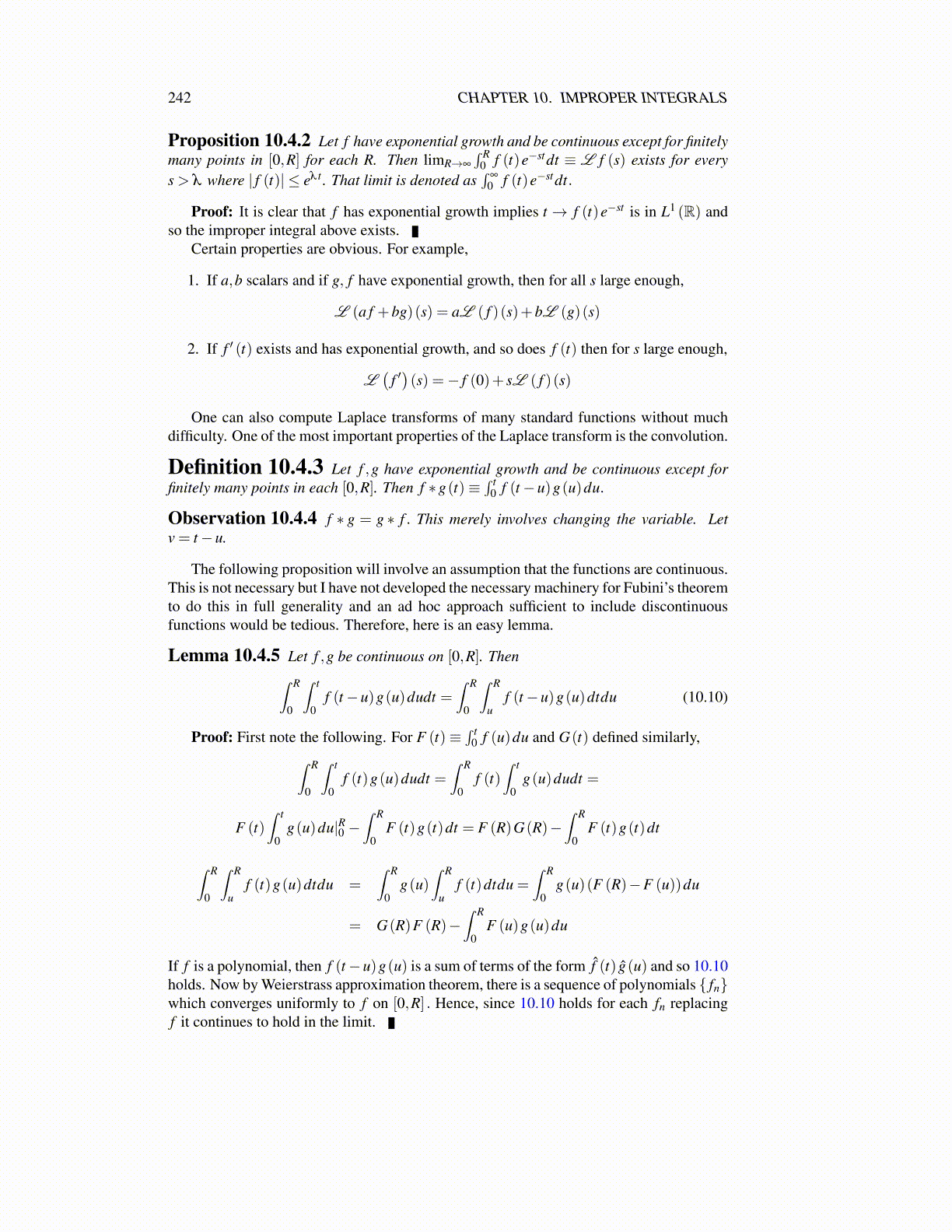
242 CHAPTER 10. IMPROPER INTEGRALS
(1− a
k
)b> b̂, so the above integral is dominated by 1
k!kk+1
(1− ak )
k+1
∫∞
b̂ xke−kxdx. Using integra-
tion by parts and Stirling’s formula which implies that for large k,k! > 12
√2πkk+(1/2)e−k,
and also that(1+ a
k
)k ≤ ea, this is dominated for large k by
1k!
kk+1(1− a
k
)k+1e−kb̂
k
k
∑j=0
b̂ j =2√
2π√
k1
1− ak
ea(1− a2
k2
)k e−k(b̂−1)
(b̂k+1−1
b̂−1
)
< e−k(b̂−1)
(b̂k+1−1
b̂−1
)
which converges to 0 as k→ ∞ since b̂ > 1.
Theorem 10.4.8 Let φ have exponential growth, |φ (t)| ≤ Cemt where we can letm≥ 0. Suppose also that φ is integrable on every interval [0,R] and let f (s)≡L (φ)(s).Then if t is a point of continuity of φ , it follows that
φ (t) = limk→∞
(−1)k
k!
[f (k)(
kt
)](kt
)k+1
.
Thus φ (t) is determined by its Laplace transform at every point of continuity.
Proof: f (s)≡∫
∞
0 e−suφ (u)du so f (k) (s) =∫
∞
0 (−u)k e−suφ (u)du. This is valid for alls large enough and the exponential growth of φ (t) thanks to Theorem 10.3.5. Formally,you differentiate under the integral. Then, always assuming k is sufficiently large,
(−1)k
k!
[f (k)(
kt
)](kt
)k+1
=(−1)k
k!
(∫∞
0(−u)k e−
kt u
φ (u)du)(
kt
)k+1
Now let v = kut so this becomes
(−1)k
k!
(∫∞
0
(− tv
k
)ke−v
φ
( tvk
) tk
dv)(
kt
)k+1
=1k!
∫∞
0vke−v
φ
( tvk
)dv
∫∞
01k! vke−vdv = 1 by Proposition 10.3.3 and so the above equals
= φ (t)+1k!
∫∞
0vke−v
(φ
( tvk
)−φ (t)
)dv
Suppose now that φ is continuous at t > 0,0 < δ < t. To say that∣∣ tv
k − t∣∣ < δ is to
say that v ∈(
t−δ
t k, t+δ
t k)
. Split the integral into one which goes from 0 to t−δ
t k, one
from t−δ
t k to t+δ
t k, and one from t+δ
t k to ∞ where δ is small enough that when∣∣ tv
k − t∣∣<
δ ,∣∣φ ( tv
k
)−φ (t)
∣∣< ε. Then the middle integral∣∣∣∣∣ 1k!
∫ t+δt k
t−δt k
vke−v(
φ
( tvk
)−φ (t)
)dv
∣∣∣∣∣≤ 1k!
∫ t+δt k
t−δt k
vke−vεdv≤ ε